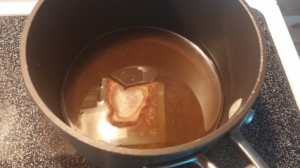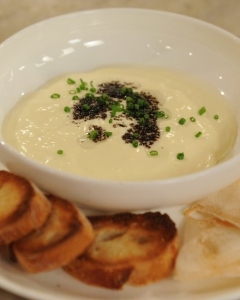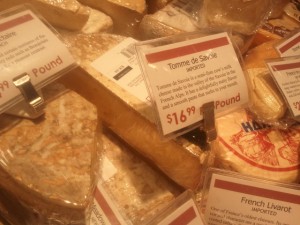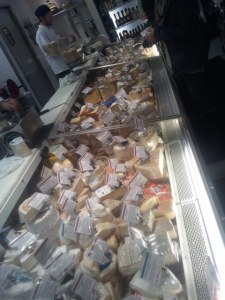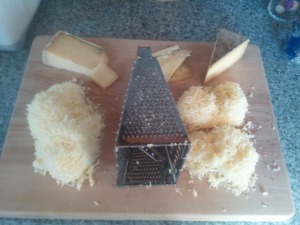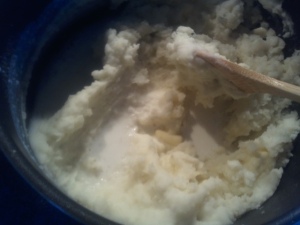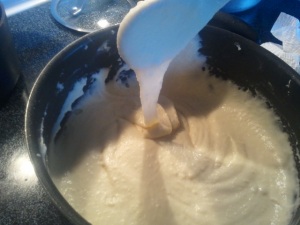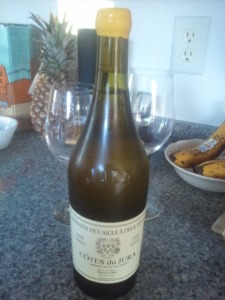(my apologies on the delay in posting, have had quite the busy and interested last couple weeks, hopefully should get a couple of these backed up posts out a little quicker than usual)
The Dish
 I remember the one time I went to France as a High School Student, part of our trip led us down somewhere to the Southern Coast (can’t remember where, I sadly wasn’t as travel-and-culinary-focused back then as I am now). When preparing for this travel, one of the biggest memories that still sticks in my mind is a heavy suggestion from my teacher to try a local specialty, “Raclette.” It looked and sounded so good… but despite my hopes I never had the chance to actually experience it, either in the group or with the family I stayed with for a week.
I remember the one time I went to France as a High School Student, part of our trip led us down somewhere to the Southern Coast (can’t remember where, I sadly wasn’t as travel-and-culinary-focused back then as I am now). When preparing for this travel, one of the biggest memories that still sticks in my mind is a heavy suggestion from my teacher to try a local specialty, “Raclette.” It looked and sounded so good… but despite my hopes I never had the chance to actually experience it, either in the group or with the family I stayed with for a week.
Though in hindsight, as I’ve learned in recent years, that was a pretty stupid thing to expect from a dish that’s inherently from the ALPINE regions of the country, near the Swiss border… not that close to the South of the country.
Its humble origins lie on the other side of that border, the original cheese being of Swiss invention instead of French, though the French do make their own Raclette near the border. 700 years ago, the cheese was the main sustenance of choice for the area farmers. After a long day of work, local shepherds, or Valais vineyard workers (some say one started it, some the other, maybe it’s just both), would sit around a fire, jamming a big block of cheese on a wood stick and sticking next to the heat to melt and soften.
This becomes the origins of the dish based solely around grilling the cheese over an open flame until it gets gooey and crisp, before letting it melt over the choice potatoes and other sides. Originally, this preparation was actually referred to as Bratchäss, Swiss for “roasted.” At some point, though, the name of both the cheese and dish changed to “Raclette,” a variation of racler, meaning “to scrape” in French, indicative of the long scrapings of melted surface cheese from the big block before returning it to the fire.
A Word On…
 The Cheese:As with many alpine-cheese-based French dishes on here, one has the choice of both a French and Swiss version of the Cheese in question. Thus there are raclettes from two different countries, if you can get the good ones from a local cheese shop. From what I was told, the Swiss version should be slightly firmer, with a simpler and singular flavor, wheras the French version contains a bit more of that funky personality. For the sake of keeping to the same goal as others, I of course went with a big, big wedge of French raclette. I wish I could have gotten a whole half-wheel like is traditional for better scraping, but that’s a lot of money!
The Cheese:As with many alpine-cheese-based French dishes on here, one has the choice of both a French and Swiss version of the Cheese in question. Thus there are raclettes from two different countries, if you can get the good ones from a local cheese shop. From what I was told, the Swiss version should be slightly firmer, with a simpler and singular flavor, wheras the French version contains a bit more of that funky personality. For the sake of keeping to the same goal as others, I of course went with a big, big wedge of French raclette. I wish I could have gotten a whole half-wheel like is traditional for better scraping, but that’s a lot of money!
On another note, in case one can’t find a “wheel” of the cheese to cut from, I’m pretty sure I’ve seen some stores have it plastic-wrapped and sold in smaller blocks (like that one greek “grilling cheese”). Though it’s not as fresh and ideal, it’ll work.
If looking for a substitute, the flavor sorta reminds me of Taleggio; just make sure you get one that’s REALLY young, while it’s still firm enough to slice and/or skewer.
The Accompaniments:Often in France, this melted cheese will be scraped over a plate with Gherkin or Cornichon pickles, pickled or raw onions, sausage, some kind of cured meat, and/or potatoes. But, other than the potatoes, I wouldn’t put any of these as stringent requirements unless one is REALLY trying to stay traditional. Just use whatever you want or have lying around the house; I roasted a pan of cherry tomatoes, bacon, and a whole onion (which I then seared to caramelized goodness) for my little plate of goodies. You can put in bell peppers, anchovies, olives, compotes, etc… or just drizzle hot cheese into your mouth.
The Melting:There’s more than one way to skin a cat, and the same goes for melting cheese… you know, just not as hairy. Of course, if one wants to make it like they did back in the day, then they’ll stick with just the one; holding it over a fire. Obviously, the bigger the chunk the better; stays on the skewer and can control the melting. Though I’ve found it can be a bit tricky to get the melting and scraping right, need a bit of time to get used to it (had quite a few messy random hodgepodges of cheese scrapings on my first attempts). But once you do it’s sorta fun.
 Other somewhat more reliable methods exist though. Such as the very one-minded appliance made exclusively for melting raclette cheese… with these tiny little skillet pans that one sticks on what looks to be a cross between a portable broiler, toaster oven, and Panini press. Cool as it is, please, for the love of god, do not be the kind of person that stoops low enough to buy it. Just use a nonstick cast iron pan in an oven or something.
Other somewhat more reliable methods exist though. Such as the very one-minded appliance made exclusively for melting raclette cheese… with these tiny little skillet pans that one sticks on what looks to be a cross between a portable broiler, toaster oven, and Panini press. Cool as it is, please, for the love of god, do not be the kind of person that stoops low enough to buy it. Just use a nonstick cast iron pan in an oven or something.
One of my favorite alternatives is just laying slices of the cheese over the desired accompaniments and broiling. It melts wonderfully, looks great, and you’re actually able to get that awesomely crispy golden crust, which I found was quite difficult to do over a fire unless one is willing to risk a higher percentage of meltage loss.
One Big Hunk of Cheese (preferably Raclette)
Cooked Potatoes (optional)
Onions, raw or cooked (optional)
Tomatoes and other Veggies (optional)
Gherkins and/or Olives (optional)
Bacon (optional)
Air-dried meats like Prosciutto (optional)
Directions
- Skewer Cheese (or just hold if large enough), holding directly over the fire until a large enough proportion has softened and melted, getting the edges crispy if possible.
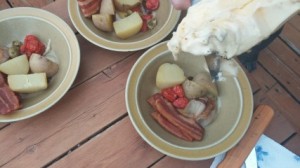
- Carefully scrape onto potatoes and other accompanying edibles as preferred. Repeat process.
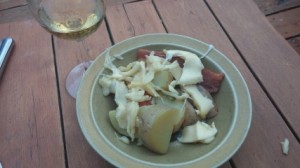
- Alternatively, arrange potatoes and accompanying in an oven-proof sauté pan.

- Slice and layer cheese over top, sticking pan under a broiler set on High. Let melt until golden and crispy around part of it.
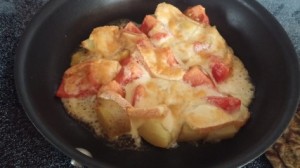
- Remove and scoop onto serving plate.
The Verdict
 I will say, using the fire to cook it is fun, but it’s a bit tricky and takes some time to get right (let alone a proper hot open-air fire, as opposed to something made in a grill box). Tedious too, gotta do one plate at a time when serving people. Though it’s cheap, I’ll admit the broiler method ended up yielding the more desired result. I actually got golden and crispy edges too, which is what I really wanted. So take that as it is and decide for yourself how you might treat it (or do like me, get a big wedge and try both!).
I will say, using the fire to cook it is fun, but it’s a bit tricky and takes some time to get right (let alone a proper hot open-air fire, as opposed to something made in a grill box). Tedious too, gotta do one plate at a time when serving people. Though it’s cheap, I’ll admit the broiler method ended up yielding the more desired result. I actually got golden and crispy edges too, which is what I really wanted. So take that as it is and decide for yourself how you might treat it (or do like me, get a big wedge and try both!).
As for the actual tastings and result…. Omnomnomnomnom. God I loooovvveee a good cheese and potato dish. The raclette really gets that nice fond-like crispiness around its surface when hot enough, and it has a deliciously mellow yet moldy/funky undertone to it, like a milder Tallegio (think I said that before though…). When you get a bite of everything all at once; cheese, potato, tomato, meat, olives or capers, onion, etc; it all ends up that perfectly harmonized blend of flavors and senses. Maybe not all that “heavenly,” but very comforting and satisfying when done right.
Oh, and it tastes pretty good without cooking too. I suggest getting the cheese for yourself at some point!
There are a couple classic pairings for this rustic mountain dish, and loads of other pairings that are suggested across the alcohol board online, but I find the most interesting is in the form of “Hot Drinks.” Being a hot, crusty dish to be eaten in the cold of winter, raclette is often drunk with similarly warmed beverages, usually some sort of tea or maybe mulled wine.
I thought it’d be fun to try the use of Mead instead of others; I like the idea of honey and cheese. Not to mention who doesn’t love a good cup of mulled mead whenever they head to the Renaissance Fair on a chilly day?
Mead and honeywine can be a tricky thing to pick out, I’ve found. Unless you’ve actually tasted it, you have no idea what a particular bottle will be like in the glass… which I guess is true for every wine and beer, but at least they have indications (region, grape, style and ageing denominations, etc). Mead only ever says mead… and I’ve tasted ones that are thick and musky like an oversweet Riesling and others that are dry and practically flavorless, without knowing either way. Gotta pick carefully.
So at the very least, this mead’s hanging label proclamation of “semi-sweet,” addition of spice packets for mulling, and Middle-age connotations was able to help me get an idea that it would be, indeed, much like the warm meads I’ve had at the local Renaissance Fair. And it was, and very tasty at that.
Tried it both chilled and mulled just for the heck of it, hard to say which one I liked better… notably different. Mulled lost the muskiness and gained a lighter, almost fresher consistency, sliding down easily to cut through the rustic funk with its warmth, while the chilled acted like a tender nectar to fill the mouth, accentuating the rustic and moldy flavors. It’s very lacking in the acid department, but the sweetness and filling mouthfeel easily make up for it, not to mention it’s comforting.
Either way it was good. And it’s from Cali, so should be a mead one can get in most if not every state.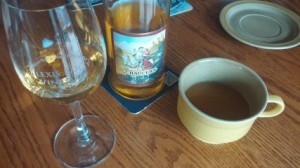
Secondary Pairing – Savoie White
A French Alpine dish, with its own strong ties to Switzerland, one just can’t plan a meal of it without considering the iconic regions hidden in that little mountain border, Jura and Savoie. Jura’s usually quite oxidative, so I’d rather stick with the simpler, continentally acidic and fresh wines of Savoie. The good quality, chasselas based whites are said to have quite the personality, great for matching up to the unique flavor. Most of what we can find in stores, though, are of the more affordable variety, less distinct but very youthful. Again, fresh and acidic, with a simple citrusy palette to cut right through the fatty and cheese profile. As one would expect and hope to drink on a cold night, tired from a day of skiing and sitting by the fire with a hot, comforting dish of melted cheese and potatoes.
Though heck, if you can find a Swiss white wine from Valais (one of their best regions for the typical Chasselas-based drink, and origin of Raclette itself), take the opportunity to marry this fated reunion post-haste.


